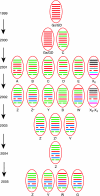Avian influenza virus (H5N1): a threat to human health
- PMID: 17428885
- PMCID: PMC1865597
- DOI: 10.1128/CMR.00037-06
Avian influenza virus (H5N1): a threat to human health
Abstract
Pandemic influenza virus has its origins in avian influenza viruses. The highly pathogenic avian influenza virus subtype H5N1 is already panzootic in poultry, with attendant economic consequences. It continues to cross species barriers to infect humans and other mammals, often with fatal outcomes. Therefore, H5N1 virus has rightly received attention as a potential pandemic threat. However, it is noted that the pandemics of 1957 and 1968 did not arise from highly pathogenic influenza viruses, and the next pandemic may well arise from a low-pathogenicity virus. The rationale for particular concern about an H5N1 pandemic is not its inevitability but its potential severity. An H5N1 pandemic is an event of low probability but one of high human health impact and poses a predicament for public health. Here, we review the ecology and evolution of highly pathogenic avian influenza H5N1 viruses, assess the pandemic risk, and address aspects of human H5N1 disease in relation to its epidemiology, clinical presentation, pathogenesis, diagnosis, and management.
Figures




References
-
- Alexander, D. J. 2000. A review of avian influenza in different bird species. Vet. Microbiol. 74:3-13. - PubMed
-
- Apisarnthanarak, A., R. Kitphati, K. Thongphubeth, P. Patoomanunt, P. Anthanont, W. Auwanit, P. Thawatsupha, M. Chittaganpitch, S. Saeng-Aroon, S. Waicharoen, P. Apisarnthanarak, G. A. Storch, L. M. Mundy, and V. J. Fraser. 2004. Atypical avian influenza (H5N1). Emerg. Infect. Dis. 10:1321-1324. - PMC - PubMed
-
- Banks, J., E. Speidel, and D. J. Alexander. 1998. Characterisation of an avian influenza A virus isolated from a human—is an intermediate host necessary for the emergence of pandemic influenza viruses? Arch. Virol. 143:781-787. - PubMed
-
- Baum, L. G., and J. C. Paulson. 1990. Sialyloligosaccharides of the respiratory epithelium in the selection of human influenza virus receptor specificity. Acta Histochem. Suppl. 40:35-38. - PubMed
Publication types
MeSH terms
Substances
Grants and funding
LinkOut - more resources
Full Text Sources
Other Literature Sources

